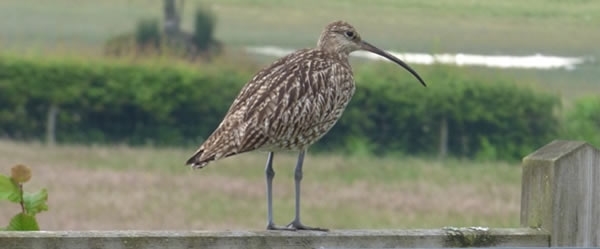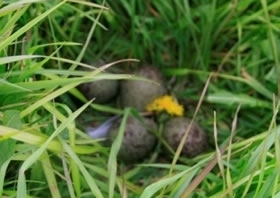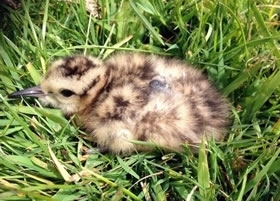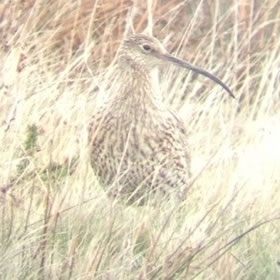By Amanda Perkins, Curlew Country Project Manager
Across the UK, curlews have been on the move from their coastal and estuarine over-wintering grounds to breed in grassland and moorland. This iconic species with its evocative bubbling call can live for over 25 years, Its Latin name Numenius Arquata refers to the curved shape of a curlew bill, like that of an archer’s bow or a new moon.
Unlike the moon however the curlew population is not waxing, just waning. Britain holds over 25% of the Eurasian curlew population but it is rapidly declining (estimates of 75% losses in Shropshire since 1990, 46% across the UK from 1994-2010 and now internationally threatened).

Curlew Country is a wader recovery project in Shropshire and the Welsh Marches. It is one of 14 projects that make up the Stiperstones and Corndon Landscape Partnership Scheme (Heritage Lottery funded and managed by local partners with the lead partner being the Shropshire Hills Area of Outstanding Natural Beauty, hosted by Shropshire Council).
The Curlew Country landscape includes moorland in the hillier areas and grassland in both the hills and river valleys with some arable areas in between. Most of the farmers the project works with have beef and sheep enterprises with a few dairy farms interspersed. The local population of around 40 pairs of curlew are site faithful, and nest in grassland.
The original focus of the project was to engage farmers in discussion about improved habitat management for waders and to encourage them into agri-environment schemes. Farmers and land managers who were approached were weary of what they saw as ‘another conservationist coming up their drive to talk with them about how to do their work’, and although mainly polite, freely expressed their opinion that there was no point in managing habitat differently if waders were going to be predated in any case.
This provided the ideal opportunity for the Curlew Country project to re-design the pre Landscape Partnership Scheme concept of how the project would work and to change the priorities and focus from imposition upon farmers and land managers to partnership with them.
 A small technical Project Advisory Group was formed and this group supported by national conservation organisations helped shape the nest monitoring project that then followed with the purpose of discovering why curlew are failing to breed successfully in the Curlew Country area.
A small technical Project Advisory Group was formed and this group supported by national conservation organisations helped shape the nest monitoring project that then followed with the purpose of discovering why curlew are failing to breed successfully in the Curlew Country area.
During the last two seasons, with the support of local farmers and landowners, over 30 nests have been closely monitored by cameras and heat sensitive buttons (thermacrons). Chicks have been monitored via radio tags, but none of them have survived to fledge successfully. Most of the nests have been predated at egg stage, mainly by foxes, although a few have been predated by badgers.
Each year one or two nests have been abandoned and last season one nest was trampled and the eggs were partly eaten by sheep, another was trampled by cattle and about three nests were lost to agricultural activities. The project’s farming partners feel attached to ‘their’ curlews and help all that they can to protect the nests and chicks, but if a nest site cannot be found they cannot withhold farming activities from one, two or even three fields that are being observed.
The chicks that have hatched have been too few and have mainly been taken too far out of signal range of the surviving defeated parent birds to give a realistic indication of what the main predators may be at chick stage.
 In 2016, the Game and Wildlife Conservation Trust advised Curlew Country of a similar project being run by Natalie Meyer of NABU in Schleswig Holstein, which was trialling electric fencing around curlew nests.
In 2016, the Game and Wildlife Conservation Trust advised Curlew Country of a similar project being run by Natalie Meyer of NABU in Schleswig Holstein, which was trialling electric fencing around curlew nests.
In the Curlew Country area only three nests have survived beyond egg stage each year. In 2016 the three nests that survived were those on which the protective electric fencing was trialled. Whilst not sustainable in the longer term, this method is now urgently needed to help the project achieve higher egg survival to hatching stage, so that the project can move on to discovering what the chicks need to survive up until fledging.
Curlew Country is focussed entirely upon wader recovery, with curlews taking the centre ground and without wider obligations it has the flexibility to act quickly both in terms of monitoring and subsequent intervention based on findings. This has also enabled it to progress quickly in a short space of time.
Fox control is being trialled this year on two sites. Whilst lethal fox control has existed on an un-structured basis in the area, with GWCT and BASC advice and training, the project aims to bring more rigour to this practice to raise standards and achieve greater effectiveness in nest protection. Other interventions will be trialled as appropriate.
This is a project at the heart of the community. A local Community Wildlife Group flagged up the problem of declining wader populations through diligent surveying of adult bird populations according to British Trust for Ornithology methodology. Many local children have never heard or heard of a curlew and young farmers with curlews nesting or foraging on their land report the same of their peers.
Arts projects, funded from a separate source, have helped to raise awareness of the plight of curlews in an engaging way and in return locals have been inspired to set up small fundraising initiatives to help the project that needs a great deal more funding than the initial £13,000 allocated to it, especially as many funding bodies will not consider a project undertaking predation control as an element of its work.
A farm business manager is working with Curlew Country farming partners to establish the true costs of supporting breeding curlew on land occupied by different types of farming enterprises, so that this can be fed back to policy makers. Farmers want to deliver good outcomes for waders, but sustainability will depend upon realistic financial support and deliverable agri-environment scheme initiatives.
In the north curlew benefit from grouse moor management and the RSPB has a curlew recovery project on upland sites. In the south, there are a number of small volunteer led projects and some local NGO initiatives, trying to reverse dramatic curlew decline, but there is no overall support for saving these birds.
 Urgent monitoring and short-term intervention measures are needed, but in the medium to longer term population monitoring, nest protection and habitat provision are all likely to be needed until curlew breeding success rises. Farmers and land managers are the key to sustainability and must be at the heart of any initiative taken to save lowland curlew.
Urgent monitoring and short-term intervention measures are needed, but in the medium to longer term population monitoring, nest protection and habitat provision are all likely to be needed until curlew breeding success rises. Farmers and land managers are the key to sustainability and must be at the heart of any initiative taken to save lowland curlew.
The call of the curlew evokes an emotional response from those whom have heard it but more widespread and pragmatic funding and action will be needed if we want to a country in which curlews can thrive. The alternative will be curtain call for curlews outside large, well-managed, mainly upland estates and reserves.
For more information about the Curlew Country project, please visit www.stiperstonesandcorndon.co.uk/curlewcountry/
Help the GWCT understand what is driving the decline in curlew
We know that curlew have been doing badly over much of their British range for some time, but very little is known about exactly where our curlew are – particularly in the lowlands. Without this information, it is almost impossible to know how best to kickstart their recovery. If you have, or have had, curlew on your land, please let us know by clicking here.